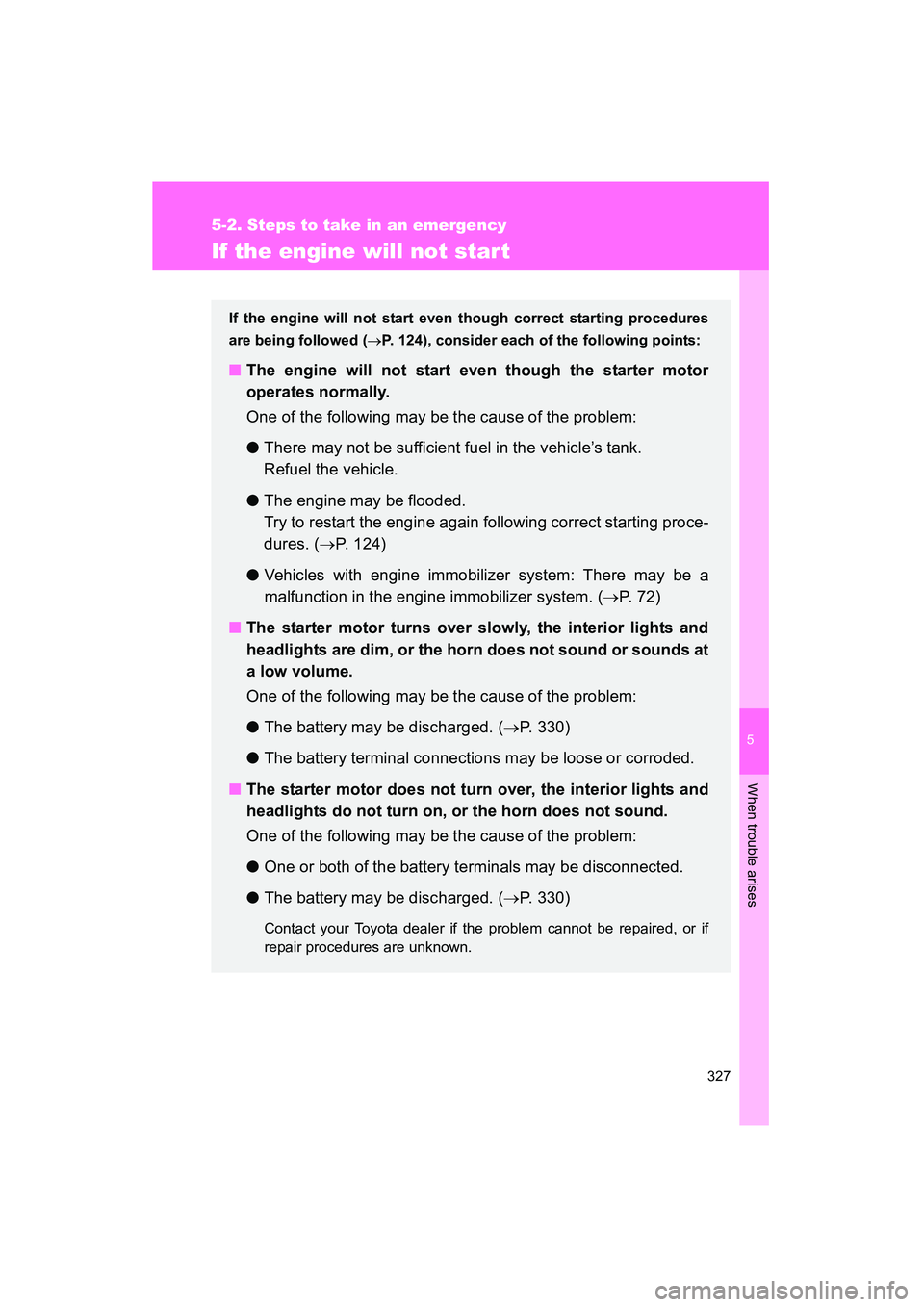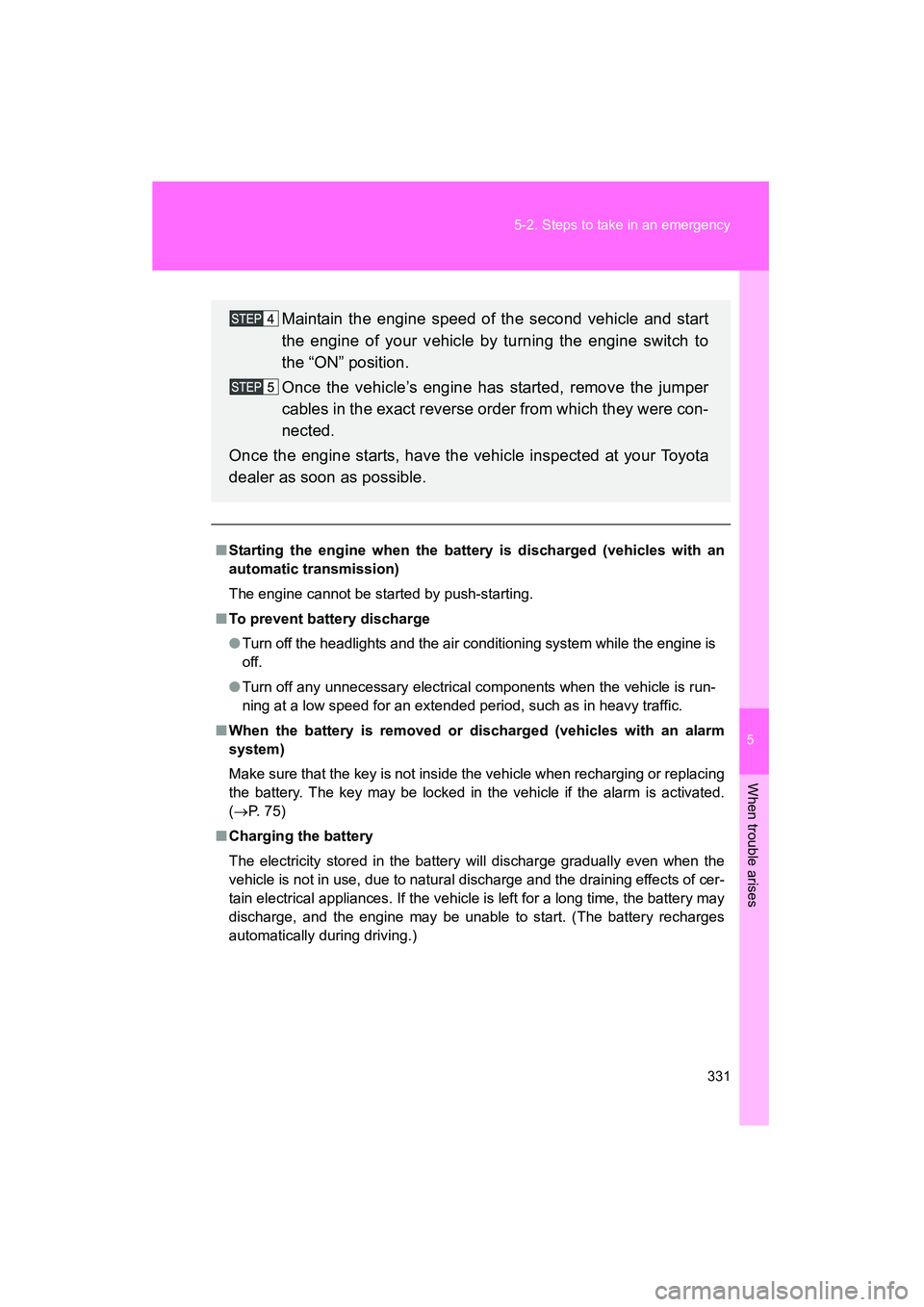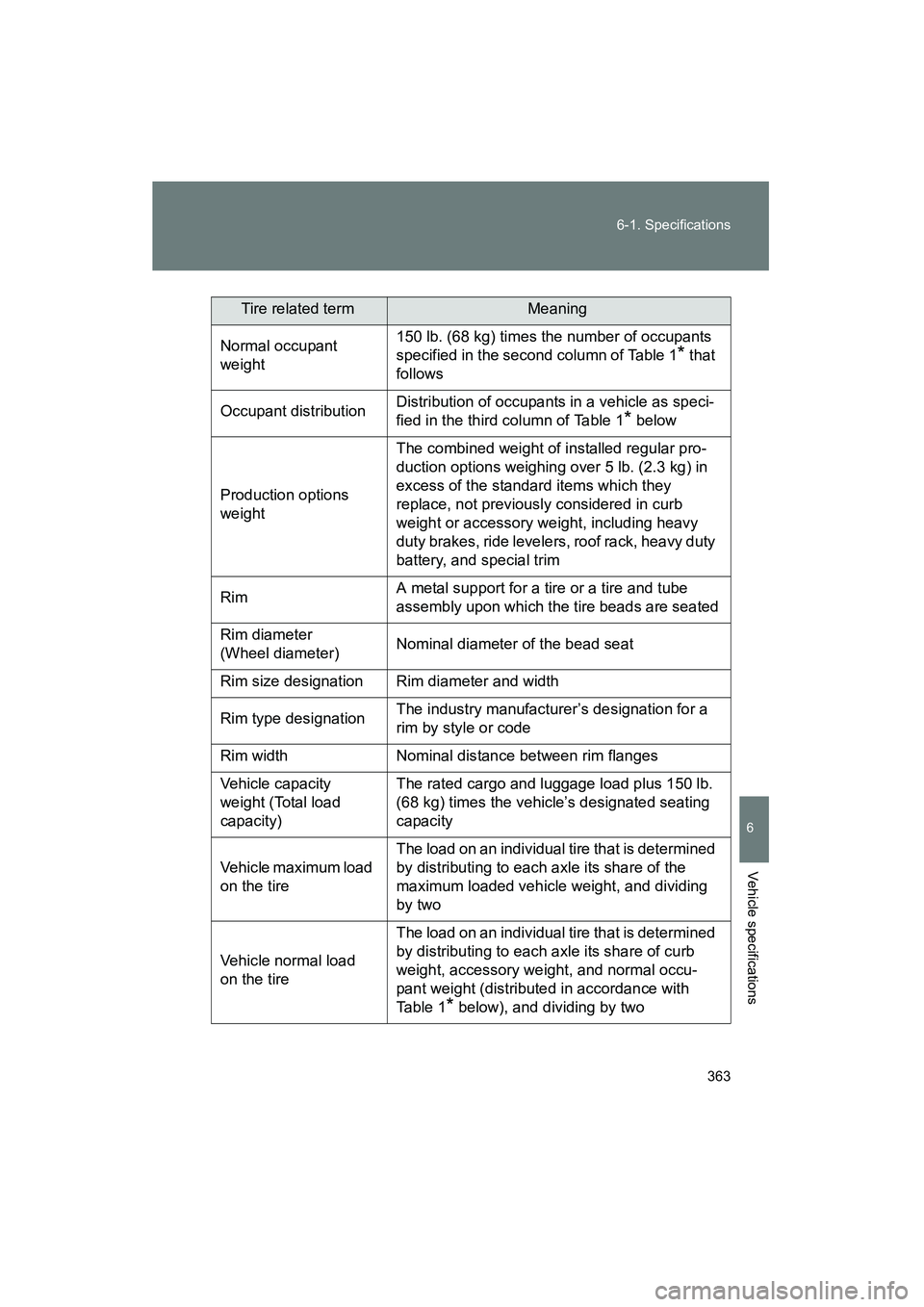Page 329 of 403

5
When trouble arises
327
5-2. Steps to take in an emergency
YARIS_HB_U_52D44U
If the engine will not start
If the engine will not start even though correct starting procedures
are being followed ( →P. 124), consider each of the following points:
■ The engine will not start even though the starter motor
operates normally.
One of the following may be the cause of the problem:
● There may not be sufficient fuel in the vehicle’s tank.
Refuel the vehicle.
● The engine may be flooded.
Try to restart the engine again following correct starting proce-
dures. ( →P. 124)
● Vehicles with engine immobilizer system: There may be a
malfunction in the engine immobilizer system. ( →P. 7 2 )
■ The starter motor turns over slowly, the interior lights and
headlights are dim, or the horn does not sound or sounds at
a low volume.
One of the following may be the cause of the problem:
● The battery may be discharged. ( →P. 330)
● The battery terminal connections may be loose or corroded.
■ The starter motor does not turn over, the interior lights and
headlights do not turn on, or the horn does not sound.
One of the following may be the cause of the problem:
● One or both of the battery terminals may be disconnected.
● The battery may be discharged. ( →P. 330)
Contact your Toyota dealer if the problem cannot be repaired, or if
repair procedures are unknown.
Page 332 of 403

330
5-2. Steps to take in an emergency
YARIS_HB_U_52D44U
If the vehicle batter y is discharged
The following procedures may be used to start the engine if the
vehicle’s battery is discharged.
You can also call your Toyota dealer or qualified repair shop.
If you have a set of jumper (or booster) cables and a second vehi-
cle with a 12-volt battery, you can jump start your vehicle by follow-
ing the steps below.Open the hood ( →P. 238)
Connect the jumper cables according to the following procedure: Connect a positive jumper cable clamp to the positive (+) battery
terminal on your vehicle.
Connect the clamp on the other end of the positive cable to the
positive (+) battery terminal on the second vehicle.
Connect a negative cable clamp to the negative (-) battery termi-
nal on the second vehicle.
Connect the clamp at the other end of the negative cable to a
solid, stationary, unpainted metallic point away from the battery
and any moving parts, as shown in the illustration. Start the engine of the second vehicle. Increase the engine
speed slightly and maintain at that level for approximately 5
minutes to recharge the battery of your vehicle.
Page 333 of 403

5
When trouble arises
331
5-2. Steps to take in an emergency
YARIS_HB_U_52D44U
■
Starting the engine when the battery is discharged (vehicles with an
automatic transmission)
The engine cannot be started by push-starting.
■ To prevent battery discharge
●Turn off the headlights and the air co nditioning system while the engine is
off.
● Turn off any unnecessary electrical components when the vehicle is run-
ning at a low speed for an extended period, such as in heavy traffic.
■ When the battery is removed or discharged (vehicles with an alarm
system)
Make sure that the key is not inside the vehicle when recharging or replacing
the battery. The key may be locked in the vehicle if the alarm is activated.
(→ P. 75)
■ Charging the battery
The electricity stored in the battery will discharge gradually even when the
vehicle is not in use, due to natural discharge and the draining effects of cer-
tain electrical appliances. If the vehicle is left for a long time, the battery may
discharge, and the engine may be unable to start. (The battery recharges
automatically during driving.)
Maintain the engine speed of the second vehicle and start
the engine of your vehicle by turning the engine switch to
the “ON” position.
Once the vehicle’s engine has started, remove the jumper
cables in the exact reverse order from which they were con-
nected.
Once the engine starts, have the vehicle inspected at your Toyota
dealer as soon as possible.
Page 334 of 403

332 5-2. Steps to take in an emergency
YARIS_HB_U_52D44U
CAUTION
■Avoiding battery fires or explosions
Observe the following precautions to prevent accidentally igniting the flam-
mable gas that may be emitted from the battery:
● Make sure each jumper cable is connected to the correct terminal and that
it is not unintentionally in contact with any other than the intended terminal.
● Do not allow the + and - clamps of the jumper cables to come into contact
with each other.
● Do not smoke, use matches, cigarette lighters or allow open flame near
the battery.
■ Battery precautions
The battery contains poisonous and corrosive acidic electrolyte, while
related parts contain lead and lead compounds. Observe the following pre-
cautions when handling the battery:
● When working with the battery, always wear safety glasses and take care
not to allow any battery fluids (acid) to come into contact with skin, clothing
or the vehicle body.
● Do not lean over the battery.
● In the event that battery fluid comes into contact with the skin or eyes,
immediately wash the affected area wi th water and seek medical attention.
Place a wet sponge or cloth over the affected area until medical attention
can be received.
● Always wash your hands after handling the battery support, terminals, and
other battery-related parts.
● Do not allow children near the battery.
■ To prevent damaging to the vehicle
Do not pull- or push-start the vehicle as the three-way catalytic converter
may overheat and become a fire hazard.
Page 350 of 403
348 6-1. Specifications
YARIS_HB_U_52D44U
Ignition system
Electrical system
Spark plug
MakeDENSO SK16R11
NGK IFR5A11
Gap0.043 in. (1.1 mm)
NOTICE
■Iridium-tipped spark plugs
Use only iridium-tipped spark plugs. Do not adjust the spark plug gap.
Battery
Specific gravity reading at
68° F (20 °C): 1.250 1.290 Fully charged
1.160 1.200 Half charged
1.060 1.100 Discharged
Charging rates
Quick charge
Slow charge 15 A max.
5 A max.
Page 365 of 403

363
6-1. Specifications
6
Vehicle specifications
YARIS_HB_U_52D44U
Normal occupant
weight150 lb. (68 kg) times the number of occupants
specified in the second column of Table 1
* that
follows
Occupant distributionDistribution of occupants in a vehicle as speci-
fied in the third column of Table 1
* below
Production options
weight
The combined weight of installed regular pro-
duction options weighing over 5 lb. (2.3 kg) in
excess of the standard items which they
replace, not previously considered in curb
weight or accessory weight, including heavy
duty brakes, ride levelers, roof rack, heavy duty
battery, and special trim
RimA metal support for a tire or a tire and tube
assembly upon which the tire beads are seated
Rim diameter
(Wheel diameter)Nominal diameter of the bead seat
Rim size designationRim diameter and width
Rim type designationThe industry manufacturer’s designation for a
rim by style or code
Rim widthNominal distance between rim flanges
Vehicle capacity
weight (Total load
capacity)The rated cargo and luggage load plus 150 lb.
(68 kg) times the vehicle’s designated seating
capacity
Vehicle maximum load
on the tire
The load on an individual tire that is determined
by distributing to each axle its share of the
maximum loaded vehicle weight, and dividing
by two
Vehicle normal load
on the tire
The load on an individual tire that is determined
by distributing to each axle its share of curb
weight, accessory weight, and normal occu-
pant weight (distributed in accordance with
Table 1
* below), and dividing by two
Tire related termMeaning
Page 372 of 403
370
6-2. Customization
YARIS_HB_U_52D44U
Items to initialize
ItemWhen to initializeReference
Maintenance data
(except Canada)After the maintenance is per-
formedP. 229
Tire pressure warning
system (if equipped)When rotating the tires on vehi-
cles with differing front and rear
tire inflation pressures
P. 255
The following items must be initialized for normal system operation
after such cases as the battery being reconnected, or maintenance
being performed on the vehicle:
Page 389 of 403

387
YARIS_HB_U_52D44U
Alphabetical index
Alphabetical index
A/C ............................................ 192
ABSABS ...................................... 162
Warning light ........................ 306
Air conditioning filter .............. 269
Air conditioning system
Air conditioning filter ............. 269
Air conditioning system................................ 192
Airbags Airbag operating conditions .... 83
Airbag precautions for your child...................................... 87
Curtain shield airbag operating conditions............. 84
Curtain shield airbag precautions .......................... 87
Front passenger occupant
classification system ............ 92
General airbag precautions .... 87
Indicators................................ 92
Locations of airbags ............... 80
Modification and disposal of airbags ............................. 91
Proper driving posture ...... 78, 87
Side airbag operating conditions............................. 84
Side airbag precautions.......... 87
SRS airbags ........................... 80
Warning light ........................ 306
Alarm .......................................... 74
Antenna ............................ 222, 224
Anti-lock brake system Anti-lock brake system ......... 162
Warning light ........................ 306
Assist grips.............................. 214
Audio input .............................. 200 Audio system
Antenna .........................222, 224
Audio input ............................ 200
AUX port/USB port ................200
Portable music player............ 200
Steering wheel audio switches ..............................201
Automatic transmission Automatic transmission ......... 127
Fluid ...................................... 349
If the shift lever cannot be shifted from P...................... 328
Indicators............................... 136
Shift lock system ...................328
AUX port/USB port ...................200
Back-up lights Replacing light bulbs .............287
Wattage .................................352
Back door ...................................38
Battery Checking ............................... 250
Gravity................................... 348
If the vehicle battery is discharged ..........................330
Preparing and checking before winter .......................172
Warning light .................305, 306
Bottle holders ...........................207
Brake assist ..............................162
Brakes
Fluid ...................................... 249
Parking brake ........................131
Specifications ........................350
Warning light ......................... 305
Break-in tips .............................114A
B